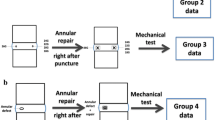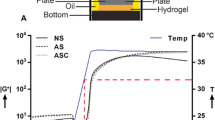Abstract
Purpose
The subtle impairments of the disc due to anular punctures may have an immediate effect on the functional integrity due to the altered intradiscal pressure, hence the subsequent catabolic degradation. This study evaluates functional restoration of needle puncture injured intervertebral discs with a newly developed injectable hydrogel using the quantitative discomanometry (QD) test. The proposed hydrogel is composed of gelatin and poly (γ-glutamic acid) (γ-PGA) and crosslinked with 1-(3-dimethylaminopropyl)-3-ethyl-carbodiimide hydrochloride (EDC).
Methods
Thirty-six bovine motion segments were distributed into six groups. Needle puncture injured discs were created in all discs except for those in the first group (intact). The second group included injured discs that received no treatment (injury). The remaining four groups included injured discs repaired with injected hydrogels fabricated with different polymer solutions and EDC concentrations including: gelatin/γ-PGA solution crosslinked with the EDC solution at a 10:1 and 40:1 ratio to form the GP/E(10:1) and GP/E(40:1) groups, respectively, and gelatin and γ-PGA solution crosslinked with the EDC solution at a 10:1 ratio to form the G/E(10:1) or P/E(10:1) groups. The QD tests were performed to evaluate disc integrity of all six groups.
Results
Among all hydrogel repair groups, the GP/E(10:1) group was found to have the highest leakage and saturate pressure and was the only group comparable to the intact one.
Conclusions
Restoration of disc integrity secondary to needle puncture injury can be achieved via the repair with the newly developed gelatin hydrogel incorporated with γ-PGA and EDC.
Graphical abstract
These slides can be retrieved under Electronic Supplementary Material.






Similar content being viewed by others
References
Galbusera F, van Rijsbergen M, Ito K, Huyghe JM, Brayda-Bruno M, Wilke HJ (2014) Ageing and degenerative changes of the intervertebral disc and their impact on spinal flexibility. Eur Spine J 23(Suppl 3):S324–S332
Vergroesen PP, Kingma I, Emanuel KS, Hoogendoorn RJ, Welting TJ, van Royen BJ, van Dieen JH, Smit TH (2015) Mechanics and biology in intervertebral disc degeneration: a vicious circle. Osteoarthr Cartil 23:1057–1070
Priyadarshani P, Li Y, Yao L (2016) Advances in biological therapy for nucleus pulposus regeneration. Osteoarthr Cartil 24:206–212
Kahanovitz N, Arnoczky SP, Sissons HA, Steiner GC, Schwarez P (1986) The effect of discography on the canine intervertebral disc. Spine (Phila Pa 1976) 11:26–27
Iatridis JC, Michalek AJ, Purmessur D, Korecki CL (2009) Localized intervertebral disc injury leads to organ level changes in structure, cellularity, and biosynthesis. Cell Mol Bioeng 2:437–447
Carragee EJ, Don AS, Hurwitz EL, Cuellar JM, Carrino JA, Herzog R (2009) 2009 ISSLS prize winner: does discography cause accelerated progression of degeneration changes in the lumbar disc: a ten-year matched cohort study. Spine (Phila Pa 1976) 34:2338–2345
Schek RM, Michalek AJ, Iatridis JC (2011) Genipin-crosslinked fibrin hydrogels as a potential adhesive to augment intervertebral disc annulus repair. Eur Cell Mater 21:373–383
Guterl CC, Torre OM, Purmessur D, Dave K, Likhitpanichkul M, Hecht AC, Nicoll SB, Iatridis JC (2014) Characterization of mechanics and cytocompatibility of fibrin-genipin annulus fibrosus sealant with the addition of cell adhesion molecules. Tissue Eng Part A 20:2536–2545
Pezowicz C (2010) Analysis of selected mechanical properties of intervertebral disc anulus fibrosus in macro and microscopic scale. J Theor Appl Mech 48:917–932
Wilke HJ, Ressel L, Heuer F, Graf N, Rath S (2013) Can prevention of a reherniation be investigated? Establishment of a herniation model and experiments with an anular closure device. Spine (Phila Pa 1976) 38:E587–E593
Hahn BS, Ji GY, Moon B, Shin DA, Ha Y, Kim KN, Yoon do H (2014) Use of annular closure device (Barricaid®) for preventing lumbar disc reherniation: one-year results of three cases. Korean J Neurotrauma 10:119–122
Long RG, Burki A, Zysset P, Eglin D, Grijpma DW, Blanquer SBG, Hecht AC, Iatridis JC (2016) Mechanical restoration and failure analyses of a hydrogel and scaffold composite strategy for annulus fibrosus repair. Acta Biomater 30:116–125
Long RG, Torre OM, Hom WW, Assael DJ, Iatridis JC (2016) Design requirements for annulus fibrosus repair: review of forces, displacements, and material properties of the intervertebral disk and a summary of candidate hydrogels for repair. J Biomech Eng 138:021007
Sierra DH, Eberhardt AW, Lemons JE (2002) Failure characteristics of multiple-component fibrin-based adhesives. J Biomed Mater Res 59:1–11
Hsu SH, Lin CH (2007) The properties of gelatin-poly (gamma-glutamic acid) hydrogels as biological glues. Biorheology 44:17–28
Wang JL, Tsai YC, Wang YH (2007) The leakage pathway and effect of needle gauge on degree of disc injury post anular puncture: a comparative study using aged human and adolescent porcine discs. Spine (Phila Pa 1976) 32:1809–1815
Wang JL, Panjabi MM, Kato Y, Nguyen C (2002) Radiography cannot examine disc injuries secondary to burst fracture: quantitative discomanometry validation. Spine (Phila Pa 1976) 27:235–240
Wang YH, Kuo TF, Wang JL (2007) The implantation of non-cell-based materials to prevent the recurrent disc herniation: an in vivo porcine model using quantitative discomanometry examination. Eur Spine J 16:1021–1027
Duarte AP, Coelho JF, Bordado JC, Cidade MT, Gil MH (2012) Surgical adhesives: systematic review of the main types and development forecast. Prog Polym Sci 37:1031–1050
Su K, Wang C (2015) Recent advances in the use of gelatin in biomedical research. Biotechnol Lett 37:2139–2145
Xing Q, Yates K, Vogt C, Qian Z, Frost MC, Zhao F (2014) Increasing mechanical strength of gelatin hydrogels by divalent metal ion removal. Sci Rep 16:4706
Luo Z, Guo Y, Liu J, Qiu H, Zhao M, Zou W, Li S (2016) Microbial synthesis of poly-γ-glutamic acid: current progress, challenges, and future perspectives. Biotechnol Biofuels 29:134
Ulubayram K, Aksu E, Gurhan SI, Serbetci K, Hasirci N (2002) Cytotoxicity evaluation of gelatin sponges prepared with different cross-linking agents. J Biomater Sci Polym Ed 13:1203–1219
Southern EP, Fye MA, Panjabi MM, Patel TC, Cholewicki J (2000) Disc degeneration: a human cadaveric study correlating magnetic resonance imaging and quantitative discomanometry. Spine (Phila Pa 1976) 25:2171–2175
Michalek AJ, Funabashi KL, Iatridis JC (2010) Needle puncture injury of the rat intervertebral disc affects torsional and compressive biomechanics differently. Eur Spine J 19:2110–2116
Michalek AJ, Iatridis JC (2012) Height and torsional stiffness are most sensitive to annular injury in large animal intervertebral discs. Spine J 12:425–432
Dreischarf M, Shirazi-Adl A, Arjmand N, Rohlmann A, Schmidt H (2016) Estimation of loads on human lumbar spine: a review of in vivo and computational model studies. J Biomech 49:833–845
Claus A, Hides J, Moseley GL, Hodges P (2008) Sitting versus standing: does the intradiscal pressure cause disc degeneration or low back pain? J Electromyogr Kinesiol 18:550–558
Wilke HJ, Neef P, Caimi M, Hoogland T, Claes LE (1999) New in vivo measurements of pressures in the intervertebral disc in daily life. Spine (Phila Pa 1976) 24:755–762
Dunn RM (2012) Cross-linking in biomaterials: a primer for clinicians. Plast Reconstr Surg 130(5 Suppl 2):18S–26S
Chuang SY, Lin LC, Tsai YC, Wang JL (2010) Exogenous crosslinking recovers the functional integrity of intervertebral disc secondary to a stab injury. J Biomed Mater Res A 92:297–302
Hedman TP, Saito H, Vo C, Chuang SY (2006) Exogenous cross-linking increases the stability of spinal motion segments. Spine (Phila Pa 1976) 31:E480–E485
Lin HJ, Lin LC, Hedman TP, Chen WP, Chuang SY (2015) Exogenous crosslinking restores intradiscal pressure of injured porcine intervertebral discs: an in vivo examination using quantitative discomanometry. Spine (Phila Pa 1976) 40:1572–1577
Fessel G, Gerber C, Snedeker JG (2012) Potential of collagen cross-linking therapies to mediate tendon mechanical properties. J Shoulder Elb Surg 21:209–217
Acknowledgements
This study was supported by Ministry of Science and Technology, Taiwan (MOST 104-2221-E-002-121-MY3, MOST 104-2221-E-002-212-MY3, MOST 104-2314-B-016-001).
Author information
Authors and Affiliations
Corresponding author
Ethics declarations
Conflict of interest
The authors report no confict of interest concerning the materials or methods used in this study or the finding specified in this paper.
Electronic supplementary material
Below is the link to the electronic supplementary material.
Rights and permissions
About this article
Cite this article
Yang, JJ., Li, F., Hung, KC. et al. Intervertebral disc needle puncture injury can be repaired using a gelatin–poly (γ-glutamic acid) hydrogel: an in vitro bovine biomechanical validation. Eur Spine J 27, 2631–2638 (2018). https://doi.org/10.1007/s00586-018-5727-5
Received:
Revised:
Accepted:
Published:
Issue Date:
DOI: https://doi.org/10.1007/s00586-018-5727-5




